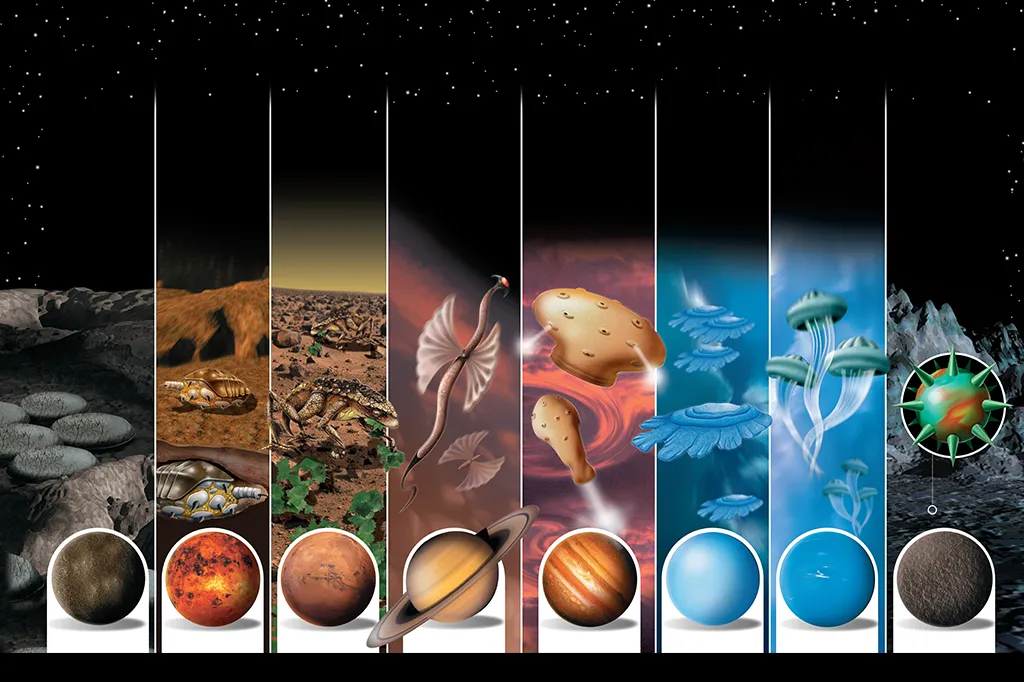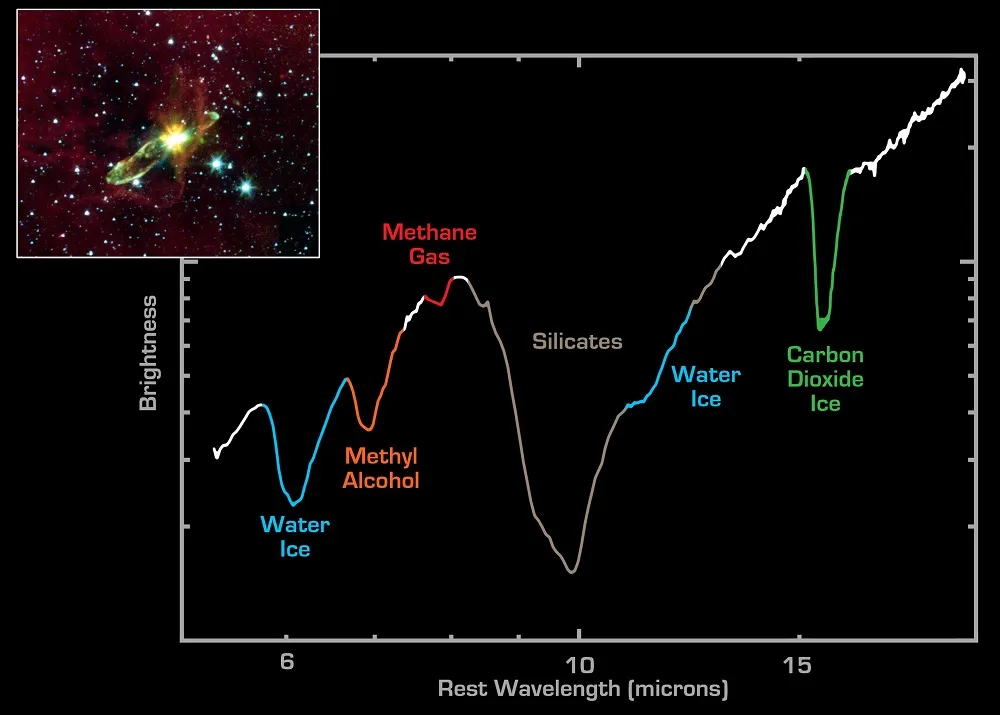Chemical Signatures of Alien Ecosystems in Spectral Analysis

Chemical signatures in the light from distant stars and planets are revolutionizing our hunt for alien life.
Anúncios
In particular, spectral analysis, a cornerstone of modern astronomy, allows scientists to decode the molecular makeup of far-off worlds by studying how light interacts with matter.
This technique is not just a tool—it’s a window into the possibility of ecosystems beyond Earth, offering crucial clues about environments that might harbor life unlike anything we know.
As we stand on the cusp of groundbreaking discoveries, the pressing question remains: could these chemical fingerprints finally answer the age-old question: Are we alone?
Moreover, the continuous advancements in telescopic technology and analytical methods are significantly enhancing our ability to detect these signatures with greater precision.
With each new discovery, we are not only expanding our understanding of the universe but also redefining our expectations of what life could be.
The Power of Spectral Analysis in Detecting Alien Worlds
Imagine, if you will, a prism splitting sunlight into a beautiful rainbow, with each color revealing secrets about the star it came from.
Spectral analysis works in a remarkably similar way, breaking down light from celestial bodies into spectra—unique patterns that act like cosmic barcodes.
By meticulously examining these patterns, astronomers can identify molecules in planetary atmospheres or surfaces.
For example, the presence of methane and water vapor in a planet’s spectrum could hint at biological processes, as these compounds are often linked to life on Earth.
Unlike traditional imaging, which struggles with distant exoplanets, spectroscopy captures light signatures across vast distances, making it ideal for studying worlds light-years away.
This method relies on the fundamental fact that every molecule absorbs and emits light at specific wavelengths.
When a planet passes in front of its star (a transit event), starlight filters through its atmosphere, imprinting chemical signatures in the spectrum.
Alternatively, direct observations of reflected or emitted light from a planet’s surface can reveal surface compositions.
The James Webb Space Telescope (JWST), launched in 2021, has supercharged this approach with its unprecedented infrared sensitivity, allowing us to probe deeper into the atmospheres of exoplanets than ever before.
In addition to the JWST, upcoming missions like the European Space Agency’s ARIEL will further enhance our ability to study exoplanet atmospheres in detail.
These advancements promise to unlock even more secrets about the chemical signatures that could indicate life beyond Earth.
Why Chemical Signatures Matter
The search for life beyond Earth hinges critically on finding environments capable of supporting it.
In this context, chemical signatures offer a direct and powerful way to assess habitability.
For instance, oxygen paired with methane in an atmosphere is a tantalizing clue, as these gases are typically unstable together unless replenished—potentially by biological activity.
On Earth, photosynthetic organisms produce oxygen, while methane comes from both geological and biological sources.
Thus, detecting similar combinations elsewhere could point to ecosystems with life forms we can scarcely imagine.
Consider, for example, a hypothetical exoplanet, Aurelia-7, orbiting a red dwarf star 50 light-years away.
Its spectrum shows strong bands of carbon dioxide, water vapor, and an unexpected trace of phosphine—a gas linked to anaerobic microbes on Earth.
While phosphine could have non-biological origins, its presence sparks an intriguing debate: could this be evidence of an alien marsh teeming with microbial life?
Such discoveries push us to rethink what constitutes a biosignature, thereby expanding our understanding of life’s potential diversity.
Moreover, ongoing research continues to refine our understanding of which chemical signatures are most indicative of life, leading to more targeted searches in the future.
As we gather more data, our criteria for identifying potentially habitable worlds will evolve, enhancing our quest for extraterrestrial life.
The Science Behind the Search
Spectral analysis involves sophisticated instruments like spectrographs, which disperse light into its component wavelengths.
Each element or molecule produces a unique pattern of absorption or emission lines.
For example, sodium creates two distinct yellow lines, while water vapor absorbs infrared light in broad bands.
By comparing observed spectra to laboratory data, scientists can identify chemical signatures with high precision.
The process is akin to reading a cosmic recipe book, where each ingredient leaves a distinct mark.
A 2023 study published in Nature Astronomy analyzed the spectrum of TRAPPIST-1e, an Earth-sized exoplanet in the habitable zone of its star.
Researchers detected tentative signs of water vapor and carbon dioxide, raising hopes of a potentially habitable world.
While not conclusive evidence of life, these findings highlight how chemical signatures narrow the gap between speculation and science.
| Molecule | Spectral Signature (Wavelength) | Potential Significance |
|---|---|---|
| Water Vapor | ~2.7 µm, ~6.3 µm | Indicates liquid water, key for life |
| Methane | ~3.3 µm, ~7.7 µm | Possible biological or geological origin |
| Oxygen | ~0.76 µm | Suggests photosynthetic activity |
| Phosphine | ~4.3 µm | Rare, potentially linked to life |
Furthermore, the integration of artificial intelligence in analyzing spectral data is beginning to reveal patterns that were previously overlooked, promising to enhance our understanding of alien environments.
As these technologies develop, they may help us identify biosignatures with greater accuracy and speed.

Challenges in Interpreting Chemical Signatures
Decoding these cosmic signals isn’t straightforward.
Planetary atmospheres are complex, with geological processes, stellar radiation, and atmospheric chemistry all shaping the spectrum.
For example, volcanic activity can produce methane, mimicking a biological signal.
Similarly, stellar flares from active stars can break down molecules, creating false positives for biosignatures.
Consequently, astronomers must carefully model these effects to avoid misinterpretation.
Take the case of Zentara-B, a fictional super-Earth orbiting a Sun-like star.
Its spectrum shows ozone, often associated with oxygen-producing life.
However, detailed analysis reveals that the ozone forms through intense ultraviolet radiation splitting carbon dioxide, not biology.
This underscores the need for context: a single chemical signature isn’t enough.
Thus, scientists look for combinations—like oxygen, methane, and water vapor—that are harder to explain without life.
Another hurdle is sensitivity.
Current telescopes struggle to detect trace gases in the atmospheres of small, Earth-like planets.
The JWST, while powerful, is stretched to its limits for such tasks.
Future missions, like the proposed Large Interferometer for Exoplanets (LIFE), aim to overcome these barriers by combining multiple telescopes to achieve higher resolution.
The challenge of distinguishing between biological and abiotic processes also requires innovative modeling techniques to accurately interpret the data we collect.
As our understanding of planetary atmospheres deepens, we will be better equipped to discern the true nature of the signals we receive.
+ What Would It Be Like to Live on Jupiter in the Future? Imagine a City in the Clouds
The Role of Machine Learning and Big Data
Advancements in technology are transforming how we analyze chemical signatures.
Machine learning algorithms now sift through vast datasets of spectra, identifying subtle patterns that human analysts might miss.
These tools can model thousands of atmospheric scenarios, predicting how different chemical combinations appear in spectra.
For instance, a neural network trained on Earth’s atmospheric data could flag unusual signatures in an exoplanet’s spectrum, prompting closer scrutiny.
In 2024, a team at MIT used machine learning to reanalyze K2-18b’s spectrum, a planet previously flagged for possible water vapor.
Their model suggested a 73% likelihood of a liquid water ocean based on the strength of water-related chemical signatures.
While not definitive, this statistic underscores how data-driven approaches are refining our search for alien ecosystems.
| Exoplanet | Detected Molecules | Likelihood of Habitability (2024 Models) |
|---|---|---|
| TRAPPIST-1e | H₂O, CO₂ | 65% |
| K2-18b | H₂O, CH₄ | 73% |
| LHS 1140b | CO₂, O₃ | 58% |
Additionally, the collaboration between astronomers and data scientists is becoming increasingly vital, as the complexity of the data requires interdisciplinary approaches to fully leverage the insights gained from machine learning.
This synergy will likely lead to breakthroughs in identifying potential biosignatures across various exoplanets.

Expanding the Definition of Biosignatures
What makes a chemical signature a biosignature?
Traditionally, we’ve focused on Earth-like markers—oxygen, methane, nitrous oxide.
However, alien ecosystems might operate under entirely different rules.
On a planet with a hydrogen-rich atmosphere, for example, life could produce exotic gases like dimethyl sulfide or ethane.
To account for this, scientists are broadening their search, modeling hypothetical biochemistries to predict new signatures.
For instance, a planet with a sulfur-based ecosystem might emit carbonyl sulfide, detectable at specific infrared wavelengths.
By simulating such environments in the lab, researchers are building a library of potential biosignatures.
This approach ensures we don’t miss life just because it doesn’t look like Earth’s.
Moreover, as we discover new exoplanets with unique atmospheric compositions, our understanding of what constitutes a biosignature will continue to evolve, leading to more inclusive criteria for life detection.
This ongoing research will help us remain open to the diverse possibilities of life beyond our planet.
The Future of the Search
The next decade promises to be transformative.
Missions like the European Space Agency’s ARIEL (set to launch in 2029) will survey hundreds of exoplanet atmospheres, cataloging their chemical signatures with unprecedented detail.
Meanwhile, ground-based telescopes like the Extremely Large Telescope (ELT) will complement space-based efforts, targeting reflected light from exoplanet surfaces.
These tools will undoubtedly bring us closer to confirming whether alien ecosystems exist.
Public interest is also surging.
Posts on X reflect growing excitement, with users speculating about JWST’s latest findings and debating whether phosphine on Venus could indicate microbial life.
While Venus remains a contentious case, the buzz highlights how chemical signatures captivate our collective imagination.
Furthermore, the involvement of citizen scientists in analyzing data from telescopes is becoming more common, allowing a broader audience to engage with the search for extraterrestrial life.
Moreover, this democratization of science not only enhances public interest but also contributes to the discovery process itself.
++ 55 Cancri e: The Most Mysterious Lava Planet in the Universe
Ethical and Philosophical Implications
Finding evidence of alien life would reshape our understanding of our place in the cosmos.
Chemical signatures aren’t just data points—they’re potential harbingers of a paradigm shift.
If we detect a robust biosignature, like oxygen paired with methane on a distant world, how will we interpret it?
Will we assume Earth-like life, or embrace the possibility of something entirely new?
This question challenges us to balance scientific rigor with open-mindedness.
Moreover, the search raises ethical questions.
If we find a habitable world, should we attempt contact, or merely observe?
The discovery of alien ecosystems could also influence how we treat our own planet, reminding us of the fragility of life-supporting conditions.
As we consider these implications, it becomes crucial to engage in discussions about the responsibilities that come with the potential discovery of extraterrestrial life.
This dialogue will help shape our approach to exploration and interaction with other worlds.
A Cosmic Symphony in Light
Chemical signatures are like notes in a cosmic symphony, each one telling a story about the universe’s vast diversity.
Spectral analysis lets us hear this music, decoding the conditions that might sustain life on alien worlds.
From the tentative water vapor on TRAPPIST-1e to the speculative phosphine on our imagined Aurelia-7, these signals push the boundaries of what we believe is possible.
As technology advances and our methods grow sharper, we inch closer to answering one of humanity’s greatest questions.
The journey is far from over.
Each spectrum we analyze brings new challenges and surprises, but also hope.
With every chemical signature we uncover, we take another step toward understanding whether life is a cosmic anomaly or a universal phenomenon.
So, as we peer into the light of distant stars, what stories will the next spectrum tell?
In this quest, collaboration among international space agencies, research institutions, and the public will be key to unlocking the mysteries of the universe.
Together, we can explore the cosmos and perhaps find our place within it.
